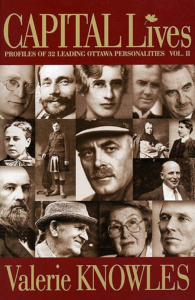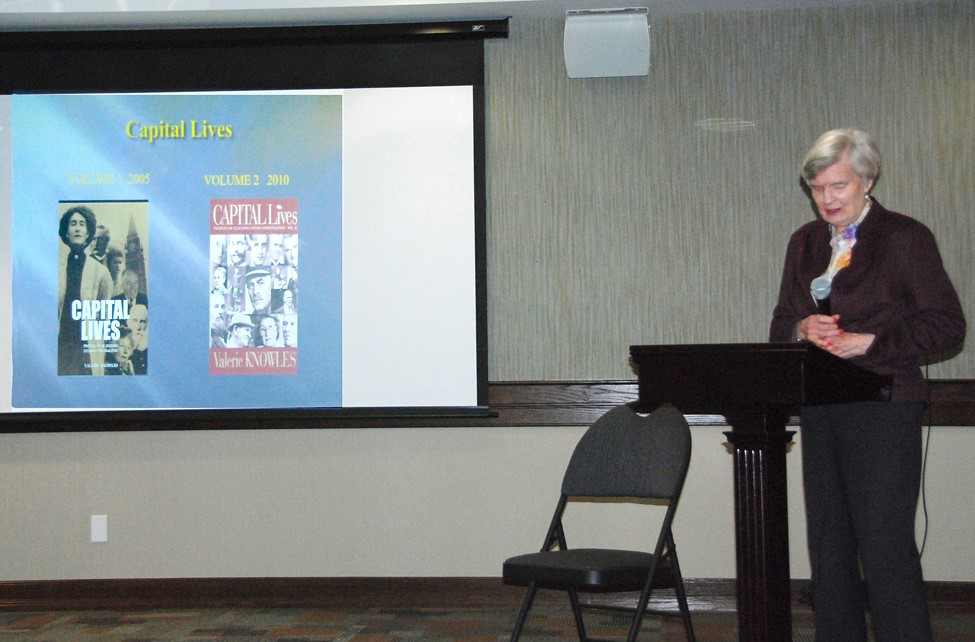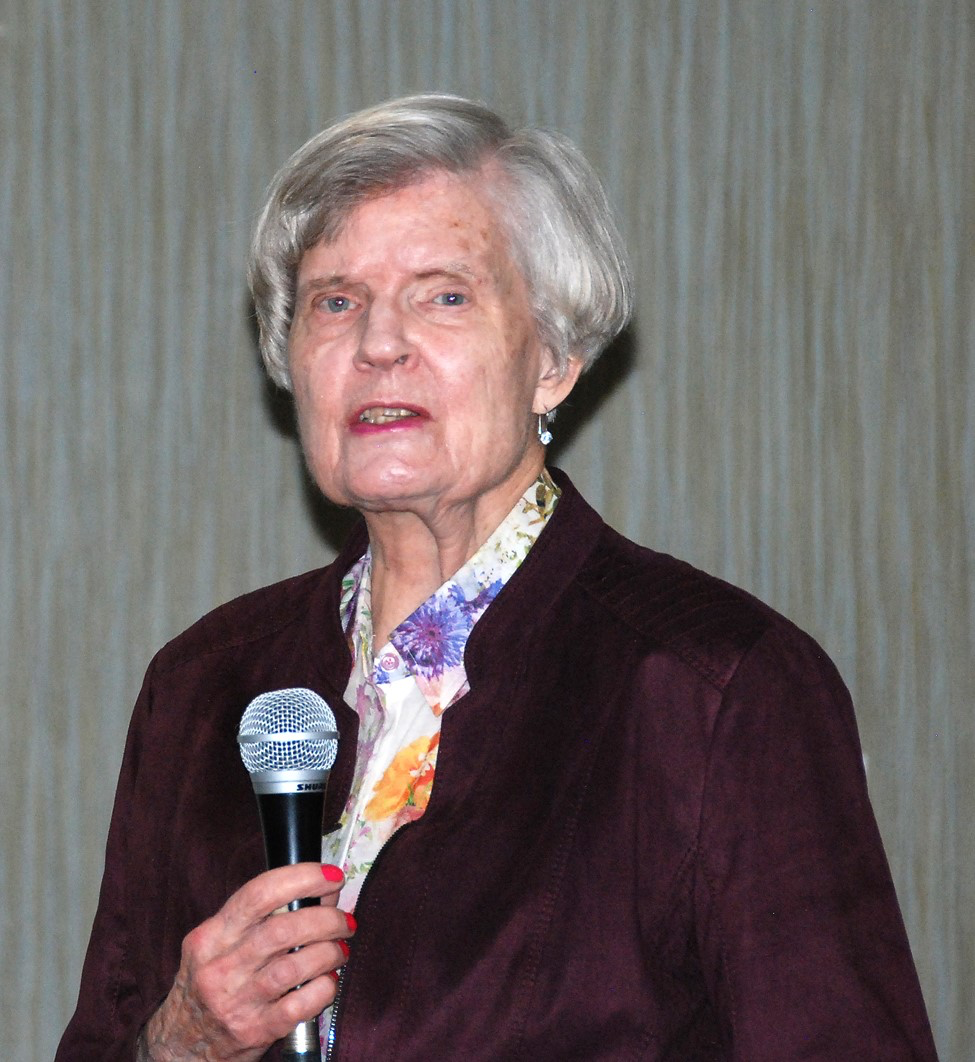Capital Lives: Hamnet Pinhey, Cecil Morrison, Isabella Preston

Presentation by Valerie Knowles. Article by Owen Cooke, Photos by Maureen McPhee. April 2018.
Valerie Knowles’ presentation provided us with insights into the lives of four Ottawa area personalities from very different time periods, all taken from her Capital Lives series.
Hamnett Kirkes Pinhey, 1784-1857, gave up a life of wealth, culture and education in England to move to the Canadian wilderness. The Pinhey name is possibly Portuguese, maybe derived from merchants in the port trade, but the family held considerable lands in Devon. Hamnett went into trade after his education. He was fluent in French and German. During the Napoleonic wars, he ran despatches into France to be forwarded to the King of Prussia.
He married Mary Anne Tasker, daughter of another successful British merchant, and they had four children.
Following the wars, he partnered with Henry Crossley, to form a ship and insurance brokerage trading into Europe. Although the business was successful, the partners fell out and spent three years in litigation.
Thus, in 1819, Pinhey retired from business, and petitioned Lord Bathurst, Colonial Secretary, for a land grant in Upper Canada. He knew about the new military settlements and “In anticipation of finding the settlers there more polished than can in general be found, I felt a penchant to enroll myself as one among them.”
In April 1820 Pinhey and his clerk sailed to Quebec, travelled by steamer to Montreal, then by ferry, stagecoach, dug-out and on foot to the banks of the Ottawa in March Township, to what we now call Pinhey’s Point. Pinhey began immediately to build Horaceville, named after his eldest son, and enlarged it several times to the building we see today. The following year he brought out his wife, children and possessions.
He became an enterprising gentleman farmer, having eighty acres under cultivation by 1827. He was an entrepreneur and dabbled in real estate, road companies and early railways. Having some medical training, he acted as a physician in the isolated area. He entertained lavishly and travelled well. He became a journalist, and remained a staunch Tory, opposing free primary education, which was being set up in Upper Canada. In 1832 he was elected to the Legislative Assembly, but was soon unseated because of election irregularities. In 1847 he was appointed to the Legislative Council. He also served as Township reeve and Warden of Dalhousie District.
Pinhey was buried at the church he built on his estate. Horaceville and Pinhey’s Point remained in the family until 1971 when it was sold to March Township and subsequently became part of City of Ottawa.
Cecil Morrison, 1890-1979, was born in Low, Quebec, son of a Scottish farmer. He was taught to read and write at home and only started primary school at age eight. He quit to work on the family farm, but was happiest working in his uncle’s store.
In 1908 he set off for Ottawa with $60. He enrolled in Willis Business College, where he met Richard Lamothe. Morrison worked for the Dominion Express Co., where he learned a valuable lesson in how to lay out delivery routes. Then he worked for the Bank of Ottawa, but left in 1915 to found the Standard Bread Co. with Dick Lamothe.
The following year he married Margaret Jane Kelly Cotter and they had three daughters, Jean, Margaret (Greta) and Gay, all of whom became prominent figures in Ottawa life.
Morrison became general manager of the Intercity Baking Co., but lost his job during the Great Depression, so he and Dick Lamothe bought the bankrupt Dominion Bakery and turned it into the Morrison-Lamothe baking, catering and frozen food empire. Morrison set up a number of progressive programmes – a comprehensive medical plan for employees, a group insurance plan and a contributory pension plan.
During the Second World War he was Canada’s Bread Administrator, within the government’s Wartime Prices and Trade Board. In 1952 he was one of the founders of a housing company to provide low-income accommodation. For Canada’s centenary in 1967 Morrison’s company designed, baked and served a twenty foot high, four-tier cake for the 1 July celebrations on Parliament Hill.
As a member of the Board of Directors of the new University of Ottawa, Morrison was instrumental in transforming a religious college into a modern university.
Trudi Le Caine, 1911-1999 became the grand dame of the arts, and more particularly music, in Ottawa. Born Gertrude Janowski in Passau on the German-Austrian border, she was raised in Czechoslovakia then in Berlin where her stepfather was a music editor and critic. The family fled when the Nazis took power, and Trudi went to Spain, but she again had to leave during the Spanish Civil War, for France, where she studied at the Sorbonne. She eventually reached Toronto, where her stepfather taught music at Upper Canada College, before becoming Director of University of Toronto’s School of Music. She had the good fortune to be able to continue her study of music.
Trudi came to Ottawa as a wartime censor, but stayed to teach music, first at Mutchmore Public School, then Broadview Public School. She used her charm over the years to create a lively arts scene in Ottawa. She was inspired by Lila Rasminsky, wife of the Governor of the Bank of Canada. She made children’s music education a particular cause, founding the Eugene Kash Children’s Concerts. She was active in the organization of Opera Lyra, the National Arts Centre Association and Espace musique.
She fell in love with the Rockefeller Center skating rink in New York and determined to bring skating to the Rideau Canal in Ottawa. She befriended Douglas Fullerton, then head of the National Capital Commission, and the first skating on the Canal opened in 1971. At nearly age fifty, she married Hugh Le Caine, a National Research Council physicist and pioneer of electronic music.
Isabella Preston, 1881-1965, was born and educated in Lancaster, England. As early as 1906 she had begun some formal education in horticulture and, when her parents died, she moved to Guelph and enrolled in the Ontario Agricultural College, today the University of Guelph. She soon withdrew to assist her professor, J.W. Crow, with practical plant hybridization. She became the first woman professional plant hybridist in Canada, and made her name by developing the “George C. Creelman” lily.
In 1920 she moved to the Central Experimental Farm in Ottawa where she remained for 27 years, working with lilies, lilacs, roses and Siberian irises. In addition to her practical work during the growing season, in winters she wrote articles, advice columns and a book. She was known as a kindly person, always ready to share her knowledge, and this continued after her retirement in 1946 to Georgetown, Ont., where she carried on her horticultural work. She is remembered today through the Isabella Preston Trophy of the North American Lily Society.
Valerie’s presentation was followed by a question and answer session, and some remarks from audience members who remembered these personalities.


